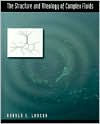5
1
9780195121971


The Structure and Rheology of Complex Fluids / Edition 1 available in Hardcover

The Structure and Rheology of Complex Fluids / Edition 1
- ISBN-10:
- 019512197X
- ISBN-13:
- 9780195121971
- Pub. Date:
- 11/26/1998
- Publisher:
- Oxford University Press
- ISBN-10:
- 019512197X
- ISBN-13:
- 9780195121971
- Pub. Date:
- 11/26/1998
- Publisher:
- Oxford University Press
249.99
In Stock

Product Details
| ISBN-13: | 9780195121971 |
|---|---|
| Publisher: | Oxford University Press |
| Publication date: | 11/26/1998 |
| Series: | Topics in Chemical Engineering |
| Edition description: | New Edition |
| Pages: | 688 |
| Product dimensions: | 9.30(w) x 7.70(h) x 1.50(d) |
About the Author
From the B&N Reads Blog

